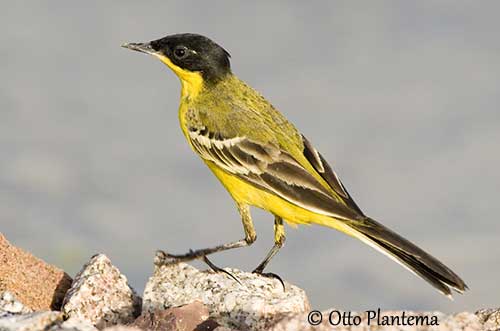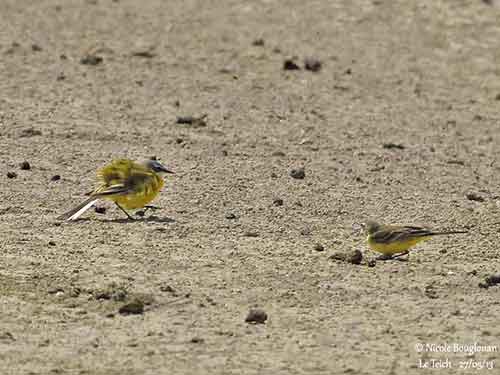
Fr: Bergeronnette printanière
Ang: Western Yellow Wagtail
All: Schafstelze
Esp: Lavandera Boyera
Ita: Cutrettola
Nd: Gele Kwikstaart
Sd: Gulärla
Photographers:
Didier Buysse
Vision d’Oiseaux
Paul Guillet
Photos d’Oiseaux
Otto Plantema
Trips around the world
Nicole Bouglouan
PHOTOGRAPHIC RAMBLE
Text by Nicole Bouglouan
Sources:
HANDBOOK OF THE BIRDS OF THE WORLD Vol 9 - by Josep del Hoyo - Andrew Elliot - David Christie - Lynx Edicions - ISBN: 8487334695
THE COMPLETE BOOK OF BRITISH BIRDS – Written by “Royal Society for the Protection of Birds” experts - Préface de Magnus Magnusson - Michael Cady- Rob Hume Editors - ISBN: 0749509112
THE HANDBOOK OF BIRD IDENTIFICATION FOR EUROPE AND THE WESTERN PALEARCTIC by Mark Beaman, Steve Madge - C. Helm - ISBN: 0713639601
ENCYCLOPEDIE DES OISEAUX DE FRANCE ET D’EUROPE – de Peter Hayman et Rob Hume - Flammarion – ISBN : 2082009920
Bradford Ornithological Group - Yellow Wagtail - Motacilla flava
Birds of Britain - The Web Magazine for Birdwatchers
Pájaros de España (JL Beamonte)
Wikipedia, the free encyclopaedia
Home page
Page Passeriformes Order
Western Yellow Wagtail
Motacilla flava
Passeriformes Order – Motacillidae Family
INTRODUCTION:
The Yellow Wagtail formerly included the global world’s population of this elegant bird, divided into seventeen subspecies. But now, two main species, the Western Yellow Wagtail - M. flava (studied in this page) and the Eastern Yellow Wagtail - M. tschutschensis, replace the Yellow Wagtail with one in W Europe and one in E Europe.
The Western Yellow Wagtail has 10-12 recognized subspecies. These races vary mainly in colour and head pattern of breeding males, whereas females and immatures are difficult to identify.
The taxonomy of this species is very complex. Some races such as M.f. lutea and M.f. feldegg are sometimes treated as separate species by some authors.
In addition, some races are known to hybridize, leading to extreme difficulties in identifying species.
DESCRIPTION OF THE BIRD:
Biometrics:
Length: 16-17 cm
Weight: M: 12-26 g – F: 11-22,5 g
The male of nominate race in breeding plumage has blue-grey head including forehead, crown, hindneck and ear-coverts, the latter sometimes darker. We can see a narrow, white supercilium from bill base to side of nape, a blackish eye stripe and a short, white submoustachial stripe.
The upperparts are greenish/olive-brown. On the upperwing, the flight feathers are blackish. Two pale wingbars are formed by the pale fringes of tertials, and pale fringes and tips of blackish wing-coverts. The tail is blackish-brown with olive fringes to feathers, but the outer rectrices are white.

The underparts are bright yellow, including chin and throat. We can see some green tinge on breast sides and flanks, and sometimes a weak olive-greenish necklace. The underwing-coverts are white.
The bill is dark grey to black. The eyes are dark brown. Legs and feet are blackish.
The female in breeding plumage has duller head pattern with greyish/grey-brown crown and brownish cheeks. She has less yellow upperparts, mostly browner. The underparts are less uniformly yellow, and especially chin and throat. The breast is buffish with variable dark brown spotting forming a necklace.
The non-breeding adults are paler, with female duller than male. The male is browner above with yellower rump, less contrasting wingbars and more obvious dark necklace. The female is paler below and also with more obvious necklace.
The immature resembles non-breeding female, and it has sometimes greener upperparts.
SUBSPECIES AND RANGE:
Twelve recognized subspecies of the Western Yellow Wagtail are mentioned below:
M.f. flavissima occurs in Britain and English Channel coasts. It winters in Sub-Saharan Africa.
The male of this race has bright yellow head with more olive hindcrown, nape, hindneck and ear-coverts. The female is darker, browner above and paler yellow below.
M.f. flava (described above) occurs in S Scandinavia S to France and central European mountain ranges, E to the Urals. It winters in Sub-Saharan Africa.

M.f. thunbergi occurs in C and N Scandinavia, E to NW Siberia. It winters in E Africa, Indian sub-continent and SE Asia.
The male has dark grey forehead, lores, forecrown and ear-coverts, fading to dark blue on hindcrown, nape and hindneck. Chin and throat have yellow centre. The female has darker crown, cheeks and upperparts than nominate, weaker supercilium and darker necklace.
M.f. iberiae occurs in SW France, Iberia and N Africa. It winters in the Gambia to the Central African Republic.
The male resembles nominate but it has white chin and throat. The female has darker cheeks and whiter chin.

M.f. cinereocapilla occurs in Sicily, Sardinia, Italy and Slovenia. It winters in Tunisia, Algeria and Mali to Lake Chad.
The male is similar to “iberiae” but the white supercilium is often absent.
M.f. pygmaea occurs in Nile Delta and Lower Egypt where it is resident all year round.
The male has dark grey crown and ear-coverts, and lacks the supercilium. Chin and throat are white.
M.f. feldegg occurs in the Balkans E to Caspian Sea, then S to Turkey, Iran and Afghanistan. It also occurs in The Levant. It winters from Nigeria to Uganda and S Sudan.
The male has glossy black head, contrasting strongly with yellow chin and throat. The female is duller overall.

M.f. lutea occurs in Lower Volga to the Irtysh River and the Lake Zaysan. It winters in Africa and Indian Sub-continent.
The male has whole head yellow.
M.f. beema occurs N of “lutea” range, E to the Ladakh area. It winters in Indian Sub-continent, eastern Africa and adjacent parts of Arabia.
The male resembles nominate but it has pale grey head and broader supercilium and female too.
M.f. melanogrisea occurs in Volga Delta, east around Caspian Sea to N Afghanistan. It winters in Pakistan and NW India to W Nepal, and possibly in NE Africa.
The male resembles “feldegg” but it has a white stripe between the yellow throat and the black head. The upperparts are brighter green with indistinct necklace.
M.f. plexa occurs in Siberia, between Khatanga and Kolyma Rivers. It winters in India and SE Asia.
The male has darker ear-coverts and lores, with more greyish mantle than “thunbergi”. The female is duller.
M.f. leucocephala occurs in NW Mongolia and adjacent parts of China and Russia. It probably winters in India.
The male has white head, yellow centre of throat and greyish hindneck.

HABITAT:
The Western Yellow Wagtail breeds in wet areas including damp grassland, from water meadows to fringes of freshwater marshes and lakes, and locally in cultivated areas, and large clearings in forests in N of range.
Outside breeding season, it is found in similar habitats and almost any form of open grassy or waterside areas.
Most races feed mainly in damp grassland, but also on bare open ground at edges of rivers, lakes or other wet areas, and in drier grassland and cereal crops.
On migration and during winter, it can be found around cattle or herds of large mammals, taking the disturbed insects.
This species occurs from lowlands up to 1000 metres of elevation, but locally in Caucasus up to 2500 metres.

CALLS AND SONGS: SOUNDS BY XENO-CANTO
The Western Yellow Wagtail gives thin, far-carrying “pseet” in flight, or a longer “swee-eep” rising towards the end. The song given from perch is a repetition of the call, interspersed with more warbling notes, also given during brief fluttering flight display ‘sriii-srriit”.
There are some variations in intensity of calls among races, and usually, the southern populations have slightly louder calls than those of other subspecies.
The race “feldegg” gives harsher “shrreep” or “psrreet”.

BEHAVIOUR IN THE WILD:
The Western Yellow Wagtail feeds on small invertebrates, both aquatic and terrestrial, and seeds. The wide variety of invertebrates includes Diptera, Hemiptera, Coleoptera, Orthoptera, Lepidoptera, Isoptera and Hymenoptera, and small crustaceans, dragonflies and grasshoppers.
On the wintering grounds in Africa, beetles adults and larvae and lepidopterans are less eaten than bugs, ants, grasshoppers and small flies, depending on the region.
Some berries, seeds and other plant material are also included in the diet.

It forages by walking on ground or in water while picking items with the bill. It performs short flights to catch preys on the wing, and may occasionally hover over the vegetation while searching for preys. It usually defends a small feeding territory, and frequently wags the tail up and down while foraging.

The Western Yellow Wagtail forms large night-time roosts in trees and tall grass in swamps. It is a gregarious species, and outside the breeding season, they may form small to large flocks.
The Western Yellow Wagtail is monogamous. They nest in solitary pairs. They are territorial and both mates defend a territory around the nest-site. The pair forms in spring.
In courtship, the male performs brief fluttering flight displays accompanied by song. On the ground, it slowly circles the female with puffed-out breast feathers, dropped wings and widely fanned tail.
Some fights between rivals often occur. Two males can be seen dancing in the air, pecking and clawing at each other.



The Western Yellow Wagtail is migratory and winters in Sub-Saharan Africa, whereas C European populations migrate to S Asia. They leave the breeding grounds from July to October depending on range and race. They arrive at their wintering areas in October. The return starts as soon as February, and the birds arrive at their breeding grounds between March and May, sometimes until early June.
They migrate by day in flocks.
The Western Yellow Wagtail in flight appears shorter-tailed than other wagtails. It performs fluttering flight during displays, but usually, the flight is undulating.

REPRODUCTION OF THIS SPECIES:
The breeding season takes place between April and August. The Western Yellow Wagtail is solitary nester. The nest is built mainly by the female, a shallow scrape or on near the ground, a grassy cup lined with animal hair.

M.f. iberiae
Female collecting nest material, here sheep's wool
The female lays 4-6 buffy-white eggs with indistinct brownish markings. Both adults incubate during 11-13 days, but the female does most of the work. The chicks are fed by both parents. They fledge between 10 and 14 days after hatching, but they remain in family group with their parents for several weeks.

M.f. flava
Adult male feeding a chick
PROTECTION / THREATS / STATUS:
The Western Yellow Wagtail is locally to very common throughout the range, but it can be uncommon in some regions.
Declines were reported in Europe between 1970 and 1990, mainly in races “flava” and “flavissima”, whereas increases were recorded in Sweden and Slovenia.
These declines are due to agriculture expansion and intensification, involving drainage of wetlands and replacement of grassland with cereals.
The declines in Continental Europe are the result of drainage, use of pesticides and dumping of manure.
The European breeding population is estimated to number 7,900,000/14,000,000 breeding pairs, equating to 23,700,000/42,000,000 individuals (BirdLife International 2004).
The Western Yellow Wagtail is currently evaluated as Least Concern.

M.f. flava
First winter